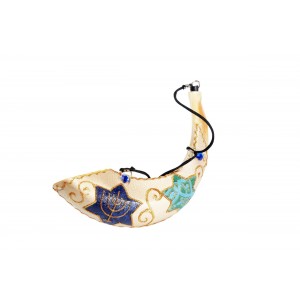Painted Shofars
The Shofar is a musical instrument made of a ram’s or kudu’s horn. Once the horn arrives at the factory, it undergoes a process of sanitation and disinfection so it can be a kosher Shofar. Ensuring the Shofar’s lawfulness is an exacting task; many Shofars are disqualified because the horns are fractured or too damaged. The Shofar is a Synagogue Item we hear during the service every year on the Jewish holiday of Rosh Hashanah, Many shofars are ornamented with a special biblical theme or embellished with hand-painted illustrations of pomegranates, Hebrew text and Shofar depictions, creating a beautiful gift for the High Holidays. A closer look on a Shofar and ornaments, will reveal the significance of this instrument in Jewish life and to God. If you are interested in learning on the special ways the Shofar relates to Rosh Hashanah and binds us to God, you will enjoy our blog post on embellished Shofars and Yom Truah. Other synagogue items important for honoring holidays like Rosh Hashanah include Tallitot and Kittels.
While most people do not know how to properly blow the Shofar in order to make the desired, breathtaking sound, it is still an item that is commonly found in Judaica stores.The Shofar, like many other articles in Judaism, varies according to custom and tradition: Iraqi and Iranian Jews often use the Bavli Shofar, which usually has a naturally incomplete finish and produces a very deep sound; Moroccans and Germans traditionally use the flat ram’s horn Shofar; Yemenites use their own Yemenite Shofar, which is more like a convoluted straight line; and the most popular and commonly-used one is the hoof-shaped classic twisted Shofar. The Shofar also varies in style and ornamentation; available in polished or natural style and being adorned with paintings in dark or light colors featuring biblical themes or unique paisley pattern. If you are having trouble deciding and choosing the perfect Shofar, read about the various styles in our blog post on how to choose the perfect Shofar.
The Shofar can be as long as you want it to be, as long as it is kosher. Synagogues usually use medium size Shofars, as it is a combination of a strong sound and convenient size. Since the Shofar has to be made of a kosher animal’s horn, and kosher large-horned animals are rare, such Shofars tend to be very expensive. For people who are traveling or want a Shofar for the living room as an accessory, a small, “baby Shofar” is perfect.
At Judaica stores, you can find Shofars that are purely decorative and perfect for the holidays.
If you are looking to purchase a Shofar as a gift since they make for very apposite Rosh Hashanah gifts, and especially if you’re looking for a decorative Shofar, your purchase will not be complete unless you get a matching Shofar stand or bag. The perfect way to showcase a gorgeous hand-painted Shofar is to place it in a silver or glass stand. The stand will make the Shofar that much more conspicuous in any room you decide to put it in. If you’re not looking to put the Shofar on display, a beautiful embroidered velvet bag will keep the Shofar intact. Feel free to contact us if you have any questions regarding Shofar designs or prices.
For More Information
For more information on painted Shofars, Judaica, or synagogue items, feel free to contact our Judaica experts with any questions or concerns.

